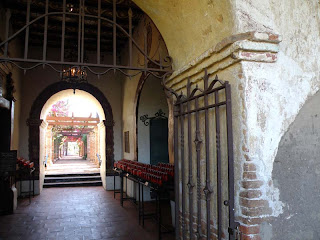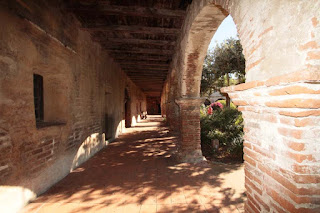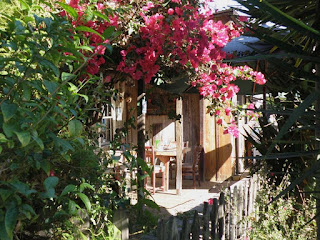It looks like we’ll make it home to Yuma (for a 3 week break) for the holidays as Marc’s project wraps up Friday night if all goes well. He’ll sleep Saturday and we’ll plan to hit the highway home early on Sunday. It’s around 310 miles but once we cross the mountains to the Palm Springs side the traffic eases tremendously. It will be such a pleasure leaving LA (the constant roar of traffic, the sirens, the nightly murders and mayhem) in the rear view mirror; you have no idea!
Nothing of any note has gone on other than Marc’s work and watching Rocket grow up. He is changing so rapidly but still the same sweet kitty only with a more pronounced personality. He’s still the master of his domain, which includes all areas of the RV, and for sure the master of my heart as he cuddles up with me every morning over coffee.
Thursday, December 13, 2012
Tuesday, November 27, 2012
San Juan Capistrano
Part I
Sandwiched between I-5 and the coastal mountains south of LA, sits the very expensive and lovely village of San Juan Capistrano. On the beautiful fall Thanksgiving weekend we ventured forth to tour the mission, founded in 1776 as one of the 21 magnificent California missions built when California was under Mexican rule. The mission has been restored throughout the centuries in an attempt to preserve and arrest its decay, which is extensive, since the original building block used was primarily adobe. In addition, there was a major earthquake in 1812 which not only killed 40 parishioners in the old stone church, but toppled it into ruin. Despite this, it still stands eerily powerful against the vivid blue skies.
In the last photo one can easily note the method of reconstruction and the new versus original stone. This was a necessary step to make it more earthquake proof for tourists.
The original 120 foot bell tower also toppled with the church so was rebuilt adjacent to the church using bells of different eras. It’s probably one of the most photographed areas of the enclave and difficult to do without hordes of people appearing in the photos. The bells are still rung on special occasions.
The mission was built in a quadrangle and quickly grew to 1000 population by 1797. Agriculture and livestock (hides and tallow) were the primary resources but this mission was also the first one to see winemaking taking place; a precursor of California’s great wine industry today. A cistern type vat inside the barracks building allowed the grapes to be stomped with the wine draining through a channel to the outside brick lined vat.
Today of course, rather than livestock, the grounds are lovingly tended gardens featuring many species of flowering plants, cacti, native trees and palms.
An adobe chapel was replaced in 1782 with Father Serra’s church and is the only surviving church known to have mass given by the famous Father. It’s ornate gold-leafed alter is about three hundred years old and originated in Barcelona, Spain. Mary Pickford was married here in 1920 and the church is still an active portion of the Catholic Parish of San Juan Capistrano.
Lastly, who can forget the swallows of San Juan Capistrano, which return 2000 miles from their winter grounds around March 19th every year? That must be a sight to see! Final random shots:
Part 2
Leaving the mission, Marc and I did a short walking tour of the historic district, now lined with well-kept old adobes, boutique shopping, and plenty of restaurants and coffee shops. We happened upon a well-preserved brick house, late 1800’s era, which belonged to one of San Juan Capistrano’s earliest settlers, “Judge” Egan. Peeking through the wavy glass door to a high-ceiling interior, we were disappointed to find it closed. From there we grabbed our picnic lunch in the town historic park and did a little driving around.
Farther along, we happened upon the Los Rios District Park and historic area. This area is also central to downtown so can be easily reached on foot from the mission. Today, with a few blocks of restaurants and small shops mixed in with old residential cottages, its claim to fame stems from it being California’s oldest continuously occupied residential area. Towering trees make meandering languid, shady, and fun. The old train depot here also serves as a stop on the areas Metrolink and Amtrak lines for those not wanting to drive to this area.
Sandwiched between I-5 and the coastal mountains south of LA, sits the very expensive and lovely village of San Juan Capistrano. On the beautiful fall Thanksgiving weekend we ventured forth to tour the mission, founded in 1776 as one of the 21 magnificent California missions built when California was under Mexican rule. The mission has been restored throughout the centuries in an attempt to preserve and arrest its decay, which is extensive, since the original building block used was primarily adobe. In addition, there was a major earthquake in 1812 which not only killed 40 parishioners in the old stone church, but toppled it into ruin. Despite this, it still stands eerily powerful against the vivid blue skies.
In the last photo one can easily note the method of reconstruction and the new versus original stone. This was a necessary step to make it more earthquake proof for tourists.
The original 120 foot bell tower also toppled with the church so was rebuilt adjacent to the church using bells of different eras. It’s probably one of the most photographed areas of the enclave and difficult to do without hordes of people appearing in the photos. The bells are still rung on special occasions.
The mission was built in a quadrangle and quickly grew to 1000 population by 1797. Agriculture and livestock (hides and tallow) were the primary resources but this mission was also the first one to see winemaking taking place; a precursor of California’s great wine industry today. A cistern type vat inside the barracks building allowed the grapes to be stomped with the wine draining through a channel to the outside brick lined vat.
Today of course, rather than livestock, the grounds are lovingly tended gardens featuring many species of flowering plants, cacti, native trees and palms.
An adobe chapel was replaced in 1782 with Father Serra’s church and is the only surviving church known to have mass given by the famous Father. It’s ornate gold-leafed alter is about three hundred years old and originated in Barcelona, Spain. Mary Pickford was married here in 1920 and the church is still an active portion of the Catholic Parish of San Juan Capistrano.
Lastly, who can forget the swallows of San Juan Capistrano, which return 2000 miles from their winter grounds around March 19th every year? That must be a sight to see! Final random shots:
Part 2
Leaving the mission, Marc and I did a short walking tour of the historic district, now lined with well-kept old adobes, boutique shopping, and plenty of restaurants and coffee shops. We happened upon a well-preserved brick house, late 1800’s era, which belonged to one of San Juan Capistrano’s earliest settlers, “Judge” Egan. Peeking through the wavy glass door to a high-ceiling interior, we were disappointed to find it closed. From there we grabbed our picnic lunch in the town historic park and did a little driving around.
Farther along, we happened upon the Los Rios District Park and historic area. This area is also central to downtown so can be easily reached on foot from the mission. Today, with a few blocks of restaurants and small shops mixed in with old residential cottages, its claim to fame stems from it being California’s oldest continuously occupied residential area. Towering trees make meandering languid, shady, and fun. The old train depot here also serves as a stop on the areas Metrolink and Amtrak lines for those not wanting to drive to this area.
Subscribe to:
Posts (Atom)



















































